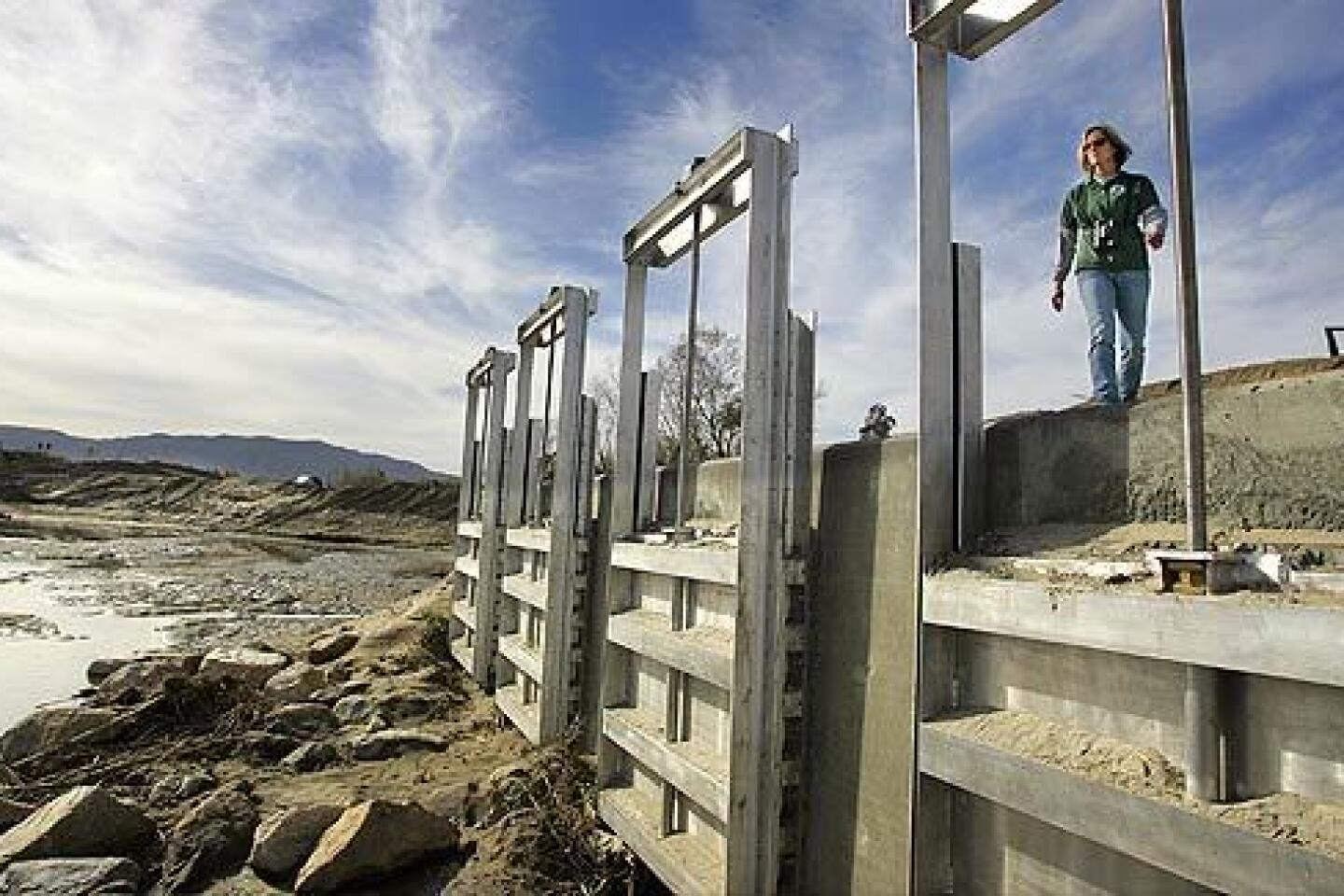Storm-damaged wetlands restored
- Share via
Robert Johnson steered his pickup carefully along an earthen levee ringing the newly renovated wetlands behind Prado Dam, which straddles the Riverside-Orange county border.
He braked to watch a red-tailed hawk soar overhead and pointed proudly to young plants already sprouting where earthmovers had recently tracked. “People ask whether we have to plant those bulrushes and cattails out there, and we tell them no. They grow alarmingly fast. By spring this area will look overgrown.”
More than two years ago, the wetlands, constructed by the Orange County Water District in 1996, were wiped out when the Santa Ana River -- which feeds into the dam’s vast reservoir -- changed course due to near-record rainfall, said Johnson, the district’s director of wetlands operations.
Earthmovers and bulldozers brought in by the water district have finished restoring more than 460 acres into a battery of large ponds, regarded as the largest man-made wetlands in Southern California.
The wetlands will act as nature’s filtration system, removing nitrates and improving water quality for millions of downstream users in Orange County.
Prado is hardly a household name in Southern California, where more high-profile wetlands -- Ballona, south of Marina del Rey; Bolsa Chica, in Huntington Beach; and, in San Diego County, Batiquitos Lagoon in Carlsbad -- historically have grabbed headlines.
But Prado is well-known among birders and environmentalists in the Inland Empire because of its size and importance in an area where new housing developments sprout on former farms and other open land.
“We used to have the agricultural land in Chino, and birds and other wildlife would go there and into Prado’s reservoir,” said Terry Wold, a conservation coordinator for the Sierra Club’s San Gorgonio chapter. “But, slowly, we’ve been taking their habitat away.”
Birders have seen great egrets, herons and ducks on tours, and the area is also habitat for the endangered least Bell’s vireo and Southwestern willow flycatcher.
Drew Feldmann, president of the San Bernardino Valley Audubon Society, said birds don’t know about property lines. “To them, it’s one large area, so we welcome whatever wetlands protection and restoration can be done.”
The wetlands project includes diverting half the Santa Ana’s flow into the pond system and subsequently into Chino Creek, where the water will rejoin the river. But recent rains have delayed the diversion until at least next month, district officials said.
“You have to understand that we’re in a flood plain here, and everything is dynamic,” said Bonnie Nash, the water district’s habitat restoration manager. “That means things out here are temporary, because if it storms, water can rush through here and wipe things out.”
Nash’s greatest fear, however, isn’t rain. It’s Arundo donax, an invasive cane that grows up to 20 feet, hogs water and chokes out native plant life along the Santa Ana.
“It’s worthless,” said Nash, who relies on a network of contractors and volunteers to keep the non-native plant in check. Arundo, she and Johnson said, clogged the Santa Ana and was partly responsible for the diversion that swept into the district’s wetlands.
That same year, more than 2,000 residents in Riverside and Orange counties living below the dam were evacuated after engineers detected seepage from the earthen structure, which at the time was holding back near-record levels of water.
They were allowed back into their homes after emergency repairs were made to the dam.
Prado, which is being raised more than 28 feet, is a crucial part of a mammoth flood-control system that protects more than 3 million people in San Bernardino, Riverside and Orange counties.
The raising of Prado is the last major piece of the flood protection plan that is part of the long-awaited Santa Ana Flood Control Project, a $1.3-billion effort to protect Orange County homes from major flooding. Federal officials have described the flood plain in the Huntington Beach and Fountain Valley area as potentially the most vulnerable west of the Mississippi.
The U.S. Army Corps of Engineers has raised the dam’s embankment and constructed new outlets, but still must build dikes, raise the spillway and put in a new operations tower. Completion of the project was expected by 2010, but that date has been pushed back by at least another year, said Greg Fuderer, a Corps spokesman.
“We’re behind our original schedule because of the flooding two years ago,” he said.
When the project is finished, the storage capacity of the dam will be increased at least 50%, reducing the need to release water into the Santa Ana River. Although the river’s flow is usually a trickle during the summer, the Santa Ana can turn destructively wild in the rainy season, and releases from the dam aggravate the problem.
Officials said the river is overdue for a great 100-year flood, which could cause $15 billion in damage to downstream communities.
One such flood occurred in the late 19th century, when settlers wrote of rowing boats from Newport Beach to Santa Ana. Another massive flood in 1938 knocked out nearly every bridge in the county, submerged large parts of Garden Grove, Westminster and Santa Ana, and killed dozens of people.
More to Read
Sign up for Essential California
The most important California stories and recommendations in your inbox every morning.
You may occasionally receive promotional content from the Los Angeles Times.


















